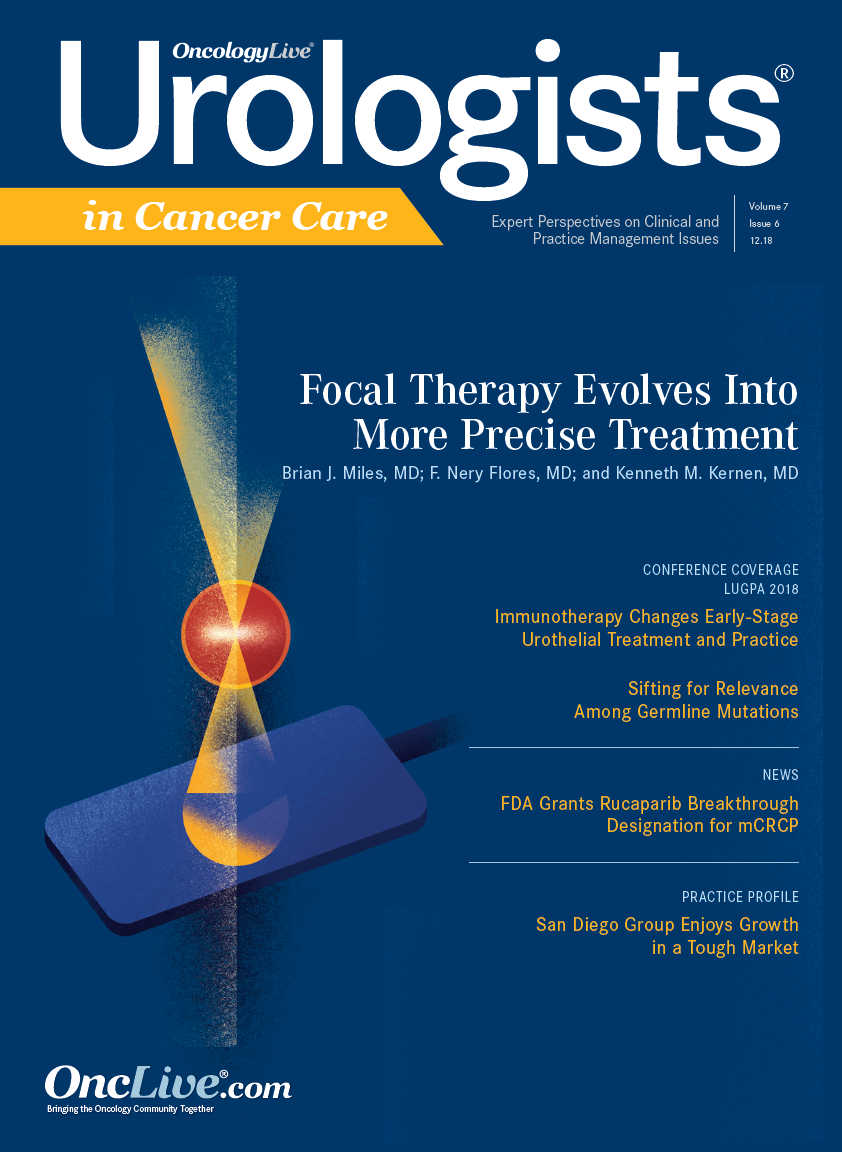Publication
Article
Special Issues
Sifting for Relevance Among Germline Mutations in Prostate Cancer
Author(s):
Up to 30% of men with prostate cancer could meet criteria for genetic evaluation for hereditary disease. The challenge is separating the mutations that are relevant from those that are not.
Sanjeev Kaul, MD

Sanjeev Kaul, MD
Up to 30% of men with prostate cancer could meet criteria for genetic evaluation for hereditary disease. The hard part, Sanjeev Kaul, MD, said at the 2018 Large Urology Group Practice Association Conference, is separating the mutations that are relevant from those that are not.
“Just identifying a mutation on one of these genes doesn’t necessarily mean that mutation is clinically significant,” said Kaul, associate professor of urology with Oakland University and William Beaumont Hospital in Royal Oak, Michigan. “You can have mutations across the entire BRCA1 or BRCA2 gene, but not all mutations are going to code for a protein, and not all coding mutations will actually affect the function of the gene.”
Moreover, there are benefits and drawbacks to testing. With those data, physicians can administer more accurate and effective treatment while avoiding potential hazards such as administering radiation to patients with mismatch repair (MMR) gene mutations. For example, radiation has been associated with increased risk for additional malignancies in patients with Lynch syndrome, which is caused by germline mutation in MMR genes.
Kaul noted that most germline gene mutations have 20% to 40% penetration among patients in general, compared with 90% for those with breast cancer; only 10% to 15% in prostate cancers are hereditary, so an actionable genetic mutation is not always present. In addition, genetic testing can be expensive and although federal law prevents payers from denying health coverage on the basis of test results, high-risk patients can be denied life insurance. Nonetheless, Kaul is a strong proponent of genetic evaluation, and there are clinical data to support his position.
Results from the GEM study published in 2017 provide crucial evidence of the importance of inherited mutations. “This was the first study run by a urology group that told us, ‘Yes, this is something that’s important,’” Kaul said.
Investigators recruited 200 men with a family history of hereditary cancer syndromes (HCSs), 62.5% of whom had prostate cancer. Participants were screened for the presence of 25 genes associated with cancer risk, including BRCA1/2, PTEN, ATM, and RAD51C. Roughly 42.0% of men in the study had a personal or family history of cancer that met criteria for an HCS.1
The overall mutation rate in the cohort was 5.5% (95% CI, 3.0%-9.9%), with a variations of unknown significance (VUS) rate of 35%. Most mutations were found in BRCA1/2, ATM, BRIP1, and MSH6, genes involved in DNA repair. The rate of mutations was highest in men with prostate cancer and a family history meeting strict criteria for any HCS (10.5%; 95% CI, 4.7%-23.4%).
“The prevalence of mutations varied broadly. In people with no prostate cancer, only 2.73% had a pathogenic or a malignant mutation,” Kaul said. “But in patients who had more aggressive cancer, Gleason [score of] 8 and above, or locally advanced cancer, the prevalence of these germline mutations was much higher; up to 8% to 10%.”
Previous data suggested that these mutations could play an important role in cancer risk. Findings presented at the American Urological Association 2016 Annual Meeting showed that African American men were more likely to have pathogenic and VUS mutations in BRCA1/2 compared with white men (7.3% vs 2.2%). Petrovics et al also observed a trend toward increased frequency of metastasis for men with these mutations compared with those without them (9.4% vs 2.4%). Patients with these mutations also had a significantly shorter time to metastasis (P = .044).2
In 2014, findings from the IMPACT study showed that, using a prostate-specific antigen (PSA) threshold of 3.0 ng/mL for detecting intermediate- and high-risk prostate cancer, the positive predictive value (PPV) of biopsy was 2.38% for BRCA2 carriers versus 0.71% in age-matched controls (P = .04). The PPV among BRCA2 mutation carriers was 48%, double what had been reported in previous population-screening studies.3
In IMPACT, Bancroft et al recruited men aged 40 to 69 years with germline BRCA1/2 mutations and a control group of men negative for a pathogenic BRCA1 or BRCA2 mutation that was known to be present in their families. The cohort included 791 BRCA1 carriers, 531 BRCA1 controls (men who had a negative predictive genetic test for the BRCA1 mutation in their family), 731 BRCA2 carriers, and 428 BRCA2 controls.
All participants underwent PSA testing at enrollment, and those with PSA >3 ng/mL (n = 199) were offered prostate biopsy. Of the 162 men who underwent biopsy, 59 received a prostate cancer diagnosis. Eighteen were BRCA1 carriers, 10 were BRCA1 controls, 24 were BRCA2 carriers, and 7 were BRCA2 controls. Sixty-six percent of cancers were intermediate or high risk.
“The PSA was higher in the BRCA-mutated group and the positive predictive value of a biopsy in the BRCAmutated group,” Kaul added.
Clinical research consistently shows that patients with these germline mutations have poorer outcomes, Kaul said. Furthermore, the data have shown repeatedly that BRCA1/2 are the most impactful genes in hereditary cancer. Patients with these mutations have a higher prevalence of disease, and their disease is more aggressive.
Impact on Patient Care
Other genes have been shown to have clinical significance. The presence of MMR genes and HOXB13 is associated with higher risk for developing prostate cancer and a higher risk for more advanced disease at diagnosis. CHEK2 is associated with a 9-times greater risk for hereditary or familial disease. ATM, a target for poly (ADP-ribose) polymerase (PARP) inhibitors, is associated with an accelerated development of metastases and shorter disease-specific survival.Men with a germline mutation also have a greater risk for additional cancers. Kaul said the presence of a BRCA2 mutation increases the risk for pancreatic cancer up to 36% compared with 0.5% in the general population. BRCA2 increases the risk for melanoma up to 76% compared with 1.6% in the general population. Therefore, patients who are positive for genes associated with hereditary cancer risk require more rigorous surveillance.
“Screening for prostate cancer in this group of patients, especially if they [don’t appear to have cancer], should have a higher index of suspicion,” Kaul said. “Screen these patients more carefully than the general population.”
However, some of these mutations can be targets for treatment. PD-1 inhibitors target the MMR genes, and PARP inhibitors are proven effective in patients with BRCA1. Androgen deprivation therapy has shown positive results for men with metastatic disease.
In 2017, the National Comprehensive Cancer Network added recommendations supporting family history and germline mutation testing to its prostate cancer guidelines. The guidelines were updated again this year to include testing for germline mutations in all patients with metastatic prostate cancer, as well as those with a Gleason score of 8 to 10, Gleason score of 4 + 3, and/or a PSA above 20. Patients with very low, low-, or favorable intermediate-risk disease should be tested if they have a strong family history of prostate cancer.
Kaul feels strongly that urologists should include testing for hereditary prostate cancer in regular clinical practice. The most important thing, he said, is capturing an accurate family history. He noted that 1 urology practice collected histories on 983 patients who visited the clinic over a 1-month period. The likelihood of a significant family history was 28%.
“These are just all-comers, not somebody specifically who comes to the office with a cancer,” he added. “Clearly, a significant family history is there, and you can get that in a significant proportion of your patients.”
Reference
- Giri VN, Obeid E, Gross L, et al. Inherited mutations in men undergoing multigene panel testing for prostate cancer: emerging implications for personalized prostate cancer genetic evaluation [published online May 4, 2017]. JCO Precis Onco. doi: 10.1200/PO.16.00039.
- Petrovics G, Ravindranath L, Chen Y, et al. Higher frequency of germline BRCA1 and BRCA2 mutations in African American prostate cancer. Presented at: 2016 American Urological Association Annual Meeting; May 6-10, 2016; San Diego, CA. Abstract MP39-18. jurology.com/article/S0022- 5347(16)00431-6/abstract.
- Bancroft EK, Page EC, Castro E, et al; IMPACT Collaborators. Targeted prostate cancer screening in BRCA1 and BRCA2 mutation carriers: results from the initial screening round of the IMPACT study [erratum in Eur Urol. 2015;67(6):e126. doi: 10.1016/j.eururo.2014.12.001]. Eur Urol. 2014;66(3):489-99. doi: 10.1016/j.eururo.2014.01.003.






















%20(2)%201-Recovered-Recovered-Recovered-Recovered-Recovered-Recovered-Recovered-Recovered-Recovered-Recovered-Recovered-Recovered-Recovered-Recovered-Recovered-Recovered-Recovered.jpg?fit=crop&auto=format)
%20(2)%201-Recovered-Recovered-Recovered-Recovered-Recovered-Recovered-Recovered-Recovered-Recovered-Recovered-Recovered-Recovered-Recovered-Recovered-Recovered-Recovered-Recovered.jpg?fit=crop&auto=format)
